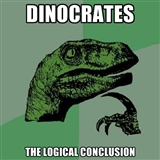Scope of the Primer
AKA the part with a subtle disclaimer about this not compensating for an actual course in logic
The purpose of this two-part primer is to introduce you, the reader, into the wonderfully complicated and interesting world of logic, the language which every internet intellectual claims to know so much about. Now, taunting others with the words “learn2logic, n00b” and “that’s a fallacy, you moron” will not only be their area of discourse, but also yours!
The basic elements of the part of logic that is discussed here are propositions. In logic, propositions are statements that can take two and only two truth values, true or false. You might say that this doesn’t look like most of the stuff we say in real life, but as this is meant to be an introduction to more complicated stuff which handle natural language [search term for the curious: argumentation theory], it is better to learn the basics and the terminology of logic first.
We also hope to tackle logical quantifiers [first-order logic] in a part 3, as it proves to be quite a handful, and understanding it requires the basic concepts introduced here.
Deductive arguments
The opposite of constructive criticism
As mentioned earlier, a simple proposition is either true or false; it cannot be neither, nor can it be both. A deductive argument is a way of proving that a certain proposition, called the conclusion, follows necessarily from a given set of propositions which are called the premises.
For the sake of argument, we assume the premises to be totally true, forever. That is, given that we accept the premises to be true, then the conclusion must necessarily be true. Another way of viewing this is that if all the premises are true, then there is no way for the conclusion to be false.
To use a common example:
P1: Men are mortal.
P2: Socrates is a man.
C: Therefore, Socrates is mortal.
Propositions P1 and P2 are the premises. Here, the premises are that men are mortal, and Socrates is a man. If we accept these to be true, then Socrates must be mortal.
When it is impossible for the conclusion to be false when the premises are true, then the whole argument is said to be valid. There is a way to test this, which will be explained later on.
Validity vs. Truth
…and Truth vs. Truthiness
A valid argument does not automatically mean that the conclusion is true, as an invalid argument also does not mean that the conclusion is false.
There is a connection between validity and truth though: An argument whose conclusion turns out to be false when the premises are true must always be invalid. That is how we define invalid arguments.
Consider our earlier example, with revised premises:
P1: Men are dinosaurs.
P2: Socrates is a man.
C: Therefore, Socrates is a dinosaur.
 Even if we can agree that Socrates is a man (P2), we know that men aren’t dinosaurs (P1). In other words, in a universe where the premises are true, we can conclude that Socrates is a dinosaur, but as we know, this is not that universe.
Even if we can agree that Socrates is a man (P2), we know that men aren’t dinosaurs (P1). In other words, in a universe where the premises are true, we can conclude that Socrates is a dinosaur, but as we know, this is not that universe.
However, the argument is still a valid one because if we accept P1 and P2 to be true, then C must be true.
An example of an invalid argument with a true conclusion is:
P1: Men are dinosaurs.
P2: Socrates is a dinosaur.
C: Therefore, Socrates is a man.
Why is this invalid? Because it doesn’t say anywhere that all dinosaurs are men. Therefore, it doesn’t mean that just because Socrates is a dino, he’s a man.
Soundness
…which is totally different from sounding; no, don’t Google that.
Soundness is the property to which every argument aspires to. An argument is sound if and only if it is valid, and all its premises are true. Basically, if your argument is sound, then you are right. Go ahead and pat yourself on the back.
The structure of logic:
P1: Oogwars are Tarlarks.
P2: A Mugwarp is an Oogwar.
C: A Mugwarp is a Tarlark.
Notice that the above argument has the exact same form as the one concluding that Socrates is a dinosaur, only that this one consists of terms which could only be gibberish. Since it has the exact same form, it must follow that this argument is valid, given that the premises are true.
Logic isn’t about finding out whether something is true or false, but in finding out whether an argument is valid or invalid. Thus, we are mainly concerned about the form of an argument. Even if I replace the term “Socrates” with “your face”, the argument would still be valid. Arguments by themselves don’t need to even be connected to each other! We will see this later in the examples.
How do we do this? How do we know that a conclusion logically follows from the premises?
From the above definition of a deductive argument, we say that a conclusion follows from the premises if, and only if the conclusion is true whenever the premises are true. Therefore, you only need to find out if there is a way that the conclusion is false even when the premises are true.
But this is kind of difficult, isn’t it? Aren’t we using the argument to prove the truth of the conclusion in the first place?
Well, the most common way of proving an argument to be invalid is to use one’s IMAGINATION to think of a situation where the opposite of the conclusion is true, but all the premises are also true. In an above example, can Socrates be immortal even if he’s a man and all men are mortal? There is a formal statement of this, which comes up in the examples from discourse.
Logical Operators
…as opposed to smooth ones.
Logical operators are symbols which we use to define relationships between statements. Naively, we are familiar with them in everyday usage, but their definitions in logic are a tad more formal.
The material implication [If…then, therefore]
Symbol: →, as in P → Q.
True if and only if whenever P is true, Q is true. The basic logical symbol. Note that when P is false, Q can take on any value and the implication is still true.
P: Wheatley is smart.
Q: I’m a potato.P→Q: If Wheatley is smart, then I’m a potato.
P→Q: Wheatley is smart, therefore I am a potato.
_______________________________________
The material equivalence [If and only if]
Symbol: ↔, as in P ↔ Q.A material implication that goes both ways. Also known to all math lovers(snicker) as the equals sign. This means that whenever P is true, Q is true, and whenever P is false, Q is false, and vice versa.
P: I am a creationist.
Q: I fail science forever.P ↔ Q: Obviously.
_______________________________________
The negation [NOT operator]
Symbol: ~, as in ~P.
It negates the statement. When P is true, ~P is false, when P is false, ~P is true.
P: I eat leaves.
~P: I do not eat leaves.
_______________________________________
The logical conjunction [AND operator]
Symbol: ∧, as in P ∧ Q.
Connects two statements together. True if and only if both statements are true.P: I love music.
Q: I love books.P ∧Q: I love music and books.
_______________________________________
The logical disjunction [OR operator]
Symbol: ∨, as in P ∨Q.
Connects two statements together. False if and only if both statements are false. Note here that this is different from the common usage of ‘or’ in language, where you cannot choose both choices. This usage is known as the exclusive disjunction, or XOR.
P: I can talk to you in English.
Q: I can talk to you in Russian.
P ∨Q: I can talk to you in English or in Russian.
_______________________________________
The tautology [T, or 1 in binary]
Symbol: T
A statement that is always true. Note that this and the contradiction aren’t operators, they are pre-defined statements.
The contradiction [F, or 0 in binary]
Symbol: F
A statement that is always false.
Got all that? Take a deep breath for a moment, or step out and get a snack. Shit is about to get real.
Truth Tables
“You can’t handle the truth!”
A truth table is a chart listing all possible combinations of truth values of a statement or statements. For example, the truth table of the NOT operator:
P ~P T F F T
It’s like a shortcut to saying that when P is true, ~P is false, and when P is false, ~P is true.
Now, the truth table of the AND operator:
P
Q
P ∧ Q
T
T
T
T
F
F
F
T
F
F
F
F
Is a clearer way of saying that the new statement made by connecting P and Q with an AND is only true when P and Q are both true.
This is a more interesting truth table, the one for material implication:
P
Q
P→Q
T
T
T
T
F
F
F
T
T
F
F
T
What does this mean? We can restate what the truth table is showing us by saying that the only way that the implication is false is if Q is false while P is true. Sound familiar? When we take P to be all the statements in the premise combined, and Q to be the conclusion, we can see that this is exactly how we determine if a conclusion is valid or invalid!
Time to put the truth table to good use. Let’s find out if this argument is valid or invalid. Consider this example:
P→Q: If I am breathing, then I must be alive.
P: I am breathing.
Q: Therefore, I am alive.First, the truth table for P→Q:
P
Q
P→Q
T
T
T
T
F
F
F
T
T
F
F
T
Then, the truth table for P ∧ (P→Q):
P
P→Q
P ∧(P→Q)
T
T
T
T
F
F
F
T
F
F
T
F
At last, the truth table for [P ∧ (P→Q)] → Q, to see if the premises, when all together, imply the conclusion:
P ∧ (P→Q)
Q
[P ∧ (P→Q)] → Q
T
T
T
F
F
T
F
T
T
F
F
T
Tada! Look at that beautiful, beautiful last column with T’s on every row. 😀
The above is an example of the rule of inference known as modus ponens. A useful exercise for you would be to construct truth tables for every one of the logical operators above, to get a feel for them.
Well, that’s it for part 1! I recommend taking a short break before going on to part 2, and of course, trying out some exercises.


